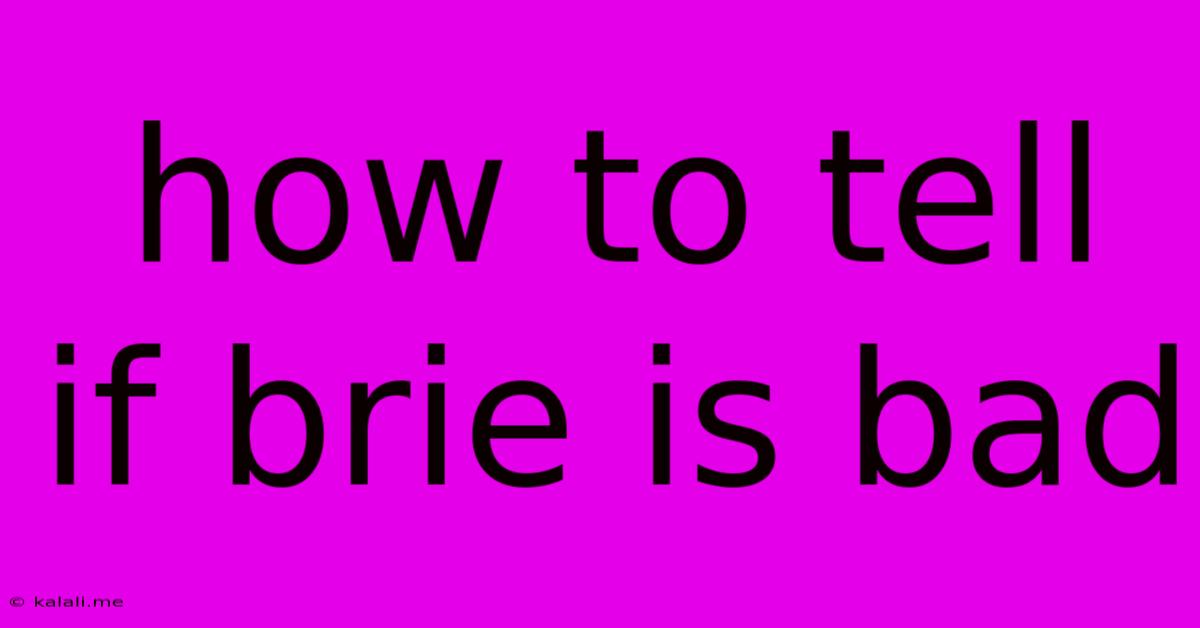How To Tell If Brie Is Bad
Kalali
May 31, 2025 · 3 min read

Table of Contents
How to Tell if Brie is Bad: A Guide to Safe Cheese Consumption
Brie, with its creamy texture and delicate, earthy flavor, is a beloved cheese. However, like all dairy products, brie can spoil if not stored and handled properly. Knowing how to identify spoiled brie is crucial to prevent foodborne illness. This guide will walk you through the key signs of bad brie, helping you ensure your cheese is safe and delicious.
Identifying Spoiled Brie: A Sensory Check
The best way to determine if your brie is past its prime is to rely on your senses – sight, smell, and touch. While the "best by" date is a guideline, it's not an absolute indicator of spoilage.
1. Visual Inspection: Look for these warning signs:
- Mold Growth: While a white rind is typical for brie, excessive mold beyond the rind is a major red flag. Green, black, or fuzzy mold indicates spoilage and should be avoided. Even if only a small portion is moldy, it's best to discard the entire wheel due to potential unseen contamination.
- Changes in Color: The paste (the interior of the cheese) should be a pale ivory to off-white color. Significant discoloration, such as browning or yellowing, especially if accompanied by other signs of spoilage, suggests the brie has gone bad.
- Slimy or Sticky Surface: The rind should be slightly firm. A slimy or sticky texture on either the rind or the paste is a clear indication that the cheese has spoiled.
- Unusual Blemishes or Cracks: While minor variations in the rind's appearance are normal, extensive cracks or unusual blemishes can indicate spoilage.
2. Smell Test: Trust Your Nose!
Smell is another crucial indicator of spoilage. Fresh brie has a pleasant, slightly earthy aroma. If your brie emits a:
- Sour or Putrid Odor: A strong, unpleasant smell, resembling ammonia or rotten milk, is a definitive sign that the cheese has gone bad. Do not consume it.
- Off-Putting Aroma: Even if not overtly foul, a noticeably different or unpleasant smell compared to fresh brie should raise concerns.
3. Texture Check: Feel the Cheese
The texture of good brie should be smooth and creamy, yet firm. Spoiled brie will often exhibit:
- Unusual Softness: Excessive softness, beyond the expected creamy texture, can indicate spoilage. The cheese might feel almost runny.
- Hard or Dry Texture: While less common, excessively hard or dry brie might also indicate spoilage.
Storage Tips to Keep Brie Fresh Longer
Proper storage is key to extending the shelf life of your brie.
- Refrigeration: Brie should always be refrigerated at temperatures below 40°F (4°C).
- Airtight Container: Store brie in an airtight container to prevent it from drying out or absorbing odors from other foods in the refrigerator. Alternatively, wrap it tightly in plastic wrap or parchment paper.
- Consume Quickly: Even when stored properly, brie is best consumed within a week or two of purchase, depending on the age of the cheese.
Conclusion:
Using your senses – sight, smell, and touch – is the most effective way to determine if your brie is safe to eat. When in doubt, always err on the side of caution and discard any cheese that shows signs of spoilage. Following proper storage guidelines can help extend the life of your brie and ensure you enjoy this delicious cheese at its best.
Latest Posts
Latest Posts
-
Mountain Bike Tire Pressure For Road
Jun 01, 2025
-
Canon Ae 1 Film Advance Lever Stuck
Jun 01, 2025
-
Sort Df By Value Of Row
Jun 01, 2025
-
What Is It Called When Someone Says Atm Machine
Jun 01, 2025
-
What Is The First Music Video
Jun 01, 2025
Related Post
Thank you for visiting our website which covers about How To Tell If Brie Is Bad . We hope the information provided has been useful to you. Feel free to contact us if you have any questions or need further assistance. See you next time and don't miss to bookmark.